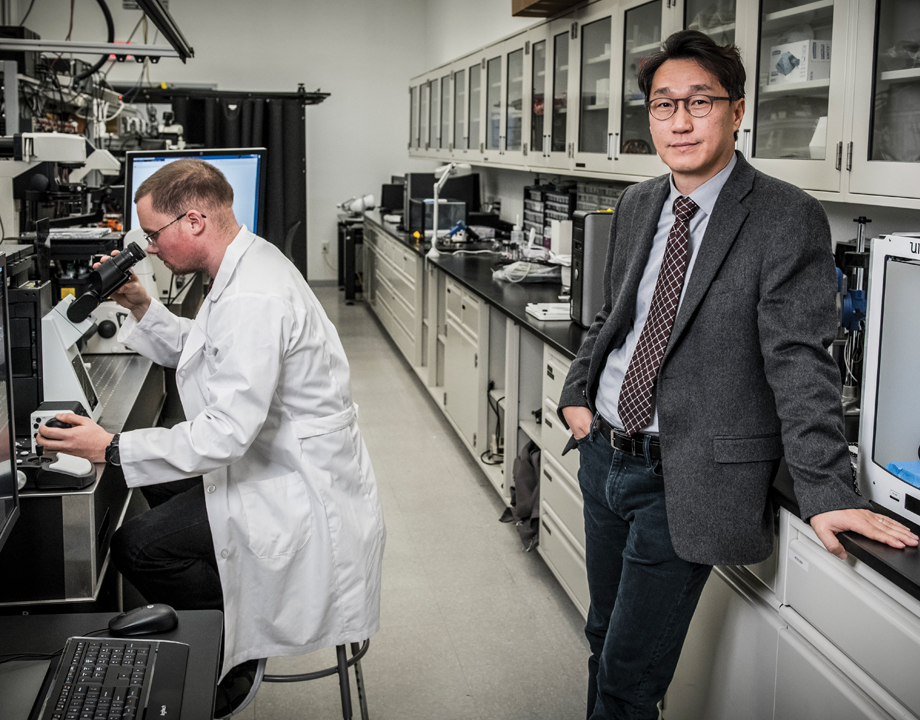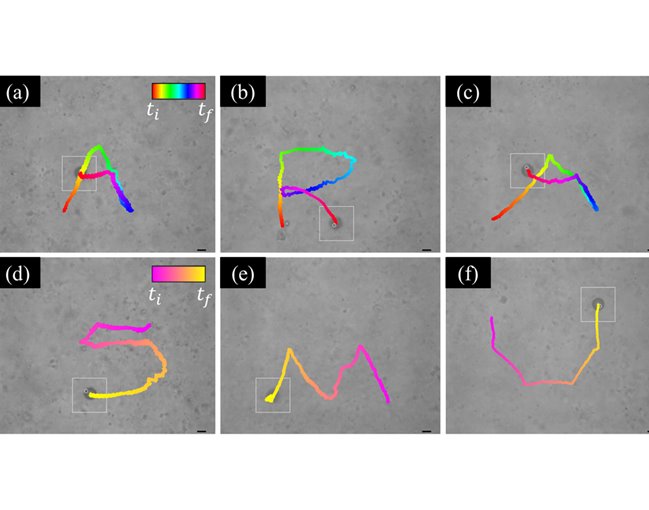Coated Particles Guided Through Mucus with Magnets
Coated Particles Guided Through Mucus with Magnets


Louis Rogowski (left) and Min Jun Kim have developed a way to coat particles so they can be controlled from outside the body with magnets, making less invasive targeted delivery plausible.
The world of medical research is filled with efforts to make tiny robotic devices—small enough to fit in a pill—that will perform anything from targeted drug delivery to surgery after being swallowed and working their way to the right spot in the body. Unfortunately, it’s that last part that is arguably the most difficult: the human body does not offer a simple single homogeneous medium through which to navigate.
“Now that we’re inside the body and trying to be inside those fluids, it’s really complicated,” said Louis Rogowski, a research scientist at Applied Research Associates, Inc. (ARA). In collaboration with Min Jun Kim from Southern Methodist University’s (SMU) Biological Actuation, Sensing, and Transport Laboratory (where Rogowski did his graduate work), Rogowski has found a way to move particles efficiently through the strangest of the body’s fluids—mucus.
The trick is to coat the particles with chemicals commonly used with drugs and steer them with magnets.
Similar Reading: Robotic Pill Tunnels to Ease Drug Delivery
In 2021, Rogowski and his colleagues at SMU proved that the robots used within a human body needn’t be complicated micro machines to move in certain biological fluids. By applying a rotating magnetic field to a particle, they found, “It can actually propel itself through a mucus-like fluid in three dimensions,” he said.
Mucus, unlike most of the other fluids in the body, is non-Newtonian and has rod-climbing-like properties. So when disturbed, the molecules that make up the fluid don’t just disperse like they would in water. When placing a rod in a bowl of certain non-Newtonian fluids and twisting it, the fluid will wrap around and climb up the rod. Similarly, a rotating magnetic field is applied to a particle embedded in mucus, the mucus will squeeze it, providing enough force to push it forward. If that same particle were in blood, or stomach acid, the rotating magnetic field would instead do nothing but make it spin in place.
In a paper Rogowski co-authored titled, “Spontaneous symmetry breaking propulsion of chemically coated magnetic microparticles,” which appeared in Nature’s Scientific Reports, he describes how coating those same particles with biotin—Bitotin-PEG3-amine, or biotin chitosan—drastically increases the speed with which they can be manipulated. The coatings are widely used with drug delivery and proven to be safe.
Stay in the Loop: Follow Mechanical Engineering magazine
“What we found is that when we applied these particular coatings to them weird things happened. And it always depended on how we were rotating them and how much magnetic force we were using,” said Rogowski. “For the chitosan coating, for instance, if we were rotating these particles really fast, they actually have almost double the velocity when compared to other coatings under the same rotation.”
Of course, there’s plenty of work to be done before patients can gulp down a pill of particles and have their doctors steer them to a mucus covered tumor. Rogowski will soon be testing his particles in live animals, where he hopes to target cancer cells to get closer to that reality. He and his team intend to experiment with many other potential coatings.
Additionally, since properly targeting anything in the body with drugs will likely require a mass of particles, they plan to up the particle count.
You Might Also Enjoy: A Mechanical Parasite for Extended Drug Release
“In this research, we’re only looking at moving single particles around,” said Rogowski. “You could extend what we’re doing here to swarms of the same micro particles, or even derivatives of them. You could have them coated with some kind of coagulation agent, so if an artery is breached you could clog that wound.” Alternatively, a swarm of aggregate microparticles could be directed to a clogged artery to unclog it, which would be less invasive than even a stent.
With ARA and SMU actively working on making this treatment a reality, someday many surgeries and medical treatments may require nothing more than popping a pill and relaxing in something like an MRI machine, while little particles swim their way toward internal injuries and growths.
Michael Abrams is a technology writer in Westfield, N.J.






